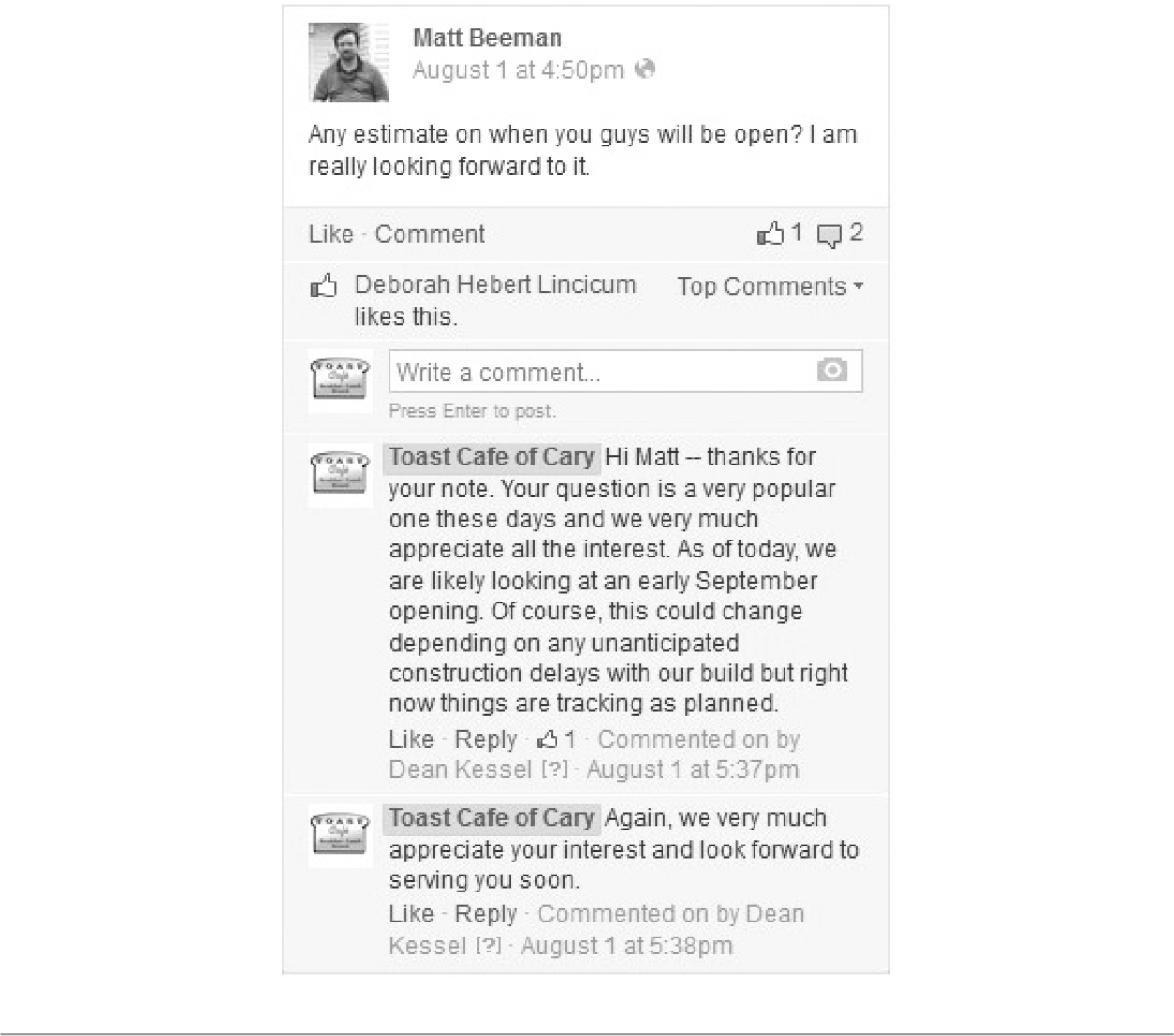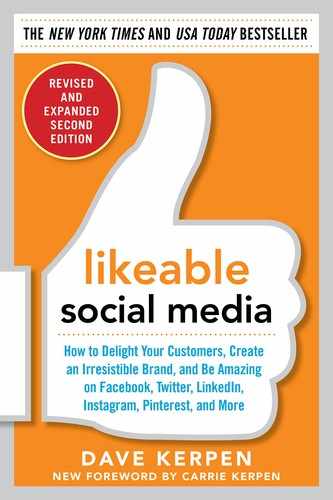
CHAPTER 7
Respond to the Good Comments Too
“Excuse me, sir,” a well-dressed woman says to you in the aisle of your department store. “I just wanted to take a moment to thank you for everything you and your company have done for me throughout the years. I am a longtime, happy customer—and you’ve truly brought joy to my life. Thanks, and keep up the great work.” You stare at her with a blank expression on your face, then turn and quickly walk away in fear there may be a complaining customer that you need to attend to elsewhere in the store.
This situation is absurd, of course, and it would never happen. You’d never reject a happy customer. Instead, you would welcome her with open arms and invite her to share more. Heck, you’d probably give her a hug or a free T-shirt, or both!
You likely embrace your happiest customers—they remind you of what you’re doing well and what your organization is all about. They’re also the best unplanned part of your marketing agenda. Word-of-mouth endorsements and conversations with satisfied customers remain the most potentially powerful marketing tools you have.
Yet each day, millions of positive comments to and about brands on social networks go unnoticed or are given no response. Visit the Facebook pages of most big organizations and you’ll find people sharing stories, asking questions, and praising products or services—almost always without a response. Do companies not have enough resources to address these posts? Are they so focused on maintaining a defensive posture with regard to all of the negative comments that they decide not to reply to any comments at all? Do companies not see value in responding to positive posts?
Whatever the reasons, they are making a mistake, possibly to your company’s advantage. If your organization begins to follow not only negative posts and comments but also positive ones, and if it takes action in responding, you are ahead of the game. In fact, if other companies aren’t doing a good job interacting with their customers or prospects through online social networking, your company looks even better to consumers when you take the initiative.
ACKNOWLEDGMENT ALONE GOES A LONG WAY—GET CREATIVE!
![]()
Just as the two simple words “I’m sorry” go a long way when a customer complains, so do the words “Thank you” when a customer has something nice to say. “Thank you” says “You matter.” “Thank you” says “We’re listening.” “Thank you” says “We appreciate you.” It’s best to further personalize your response as well, sharing your brand personality a little bit.
Develop Your Social Personality
Brand personality is formed by giving your brand human traits when presenting your company to the public. Your brand’s social personality sets you apart from other brands, giving your company unique features in an attempt to connect more directly, and more humanly, with your consumer. For example, the voice (or wording) you use to respond to posts helps shape your personality. Here are several different ways to say thanks to a positive comment, expressing the personality behind the brand:
• “Thanks a lot, Johnny. You rule!”
• “Thank you for taking the time to share.”
• “Thanks for liking us. We like you too.”
• “Thanks for your feedback, Johnny. We’re listening.”
• “Thanks for your comment, and keep spreading the good word!”
Acknowledging your customers’ positive feedback is easier today than it has ever been before. With the advent of the social Web, connecting directly to your consumer while showing that, as a brand, you truly care about your public persona ingratiates your company to current and potential customers.
Responding in Your Brand’s Voice
Language is a major part of your brand identity. Would a bank talk to its customers face-to-face using the same language that a pizzeria would? Would a pediatrician discuss a medical condition with her patients using the same language an oncologist would with his? Would a major brand target its teenage customers using the same language it uses in its ads for adults? Just as you use different language to talk to different customers face-to-face, or in advertising and marketing, and you choose that language based on who your customers are and what your organization is all about, so too must you consider the language you use on social networks in your responses.
In fact, without the advantage you have in face-to-face conversation to inflect different emotions in your voice or use nonverbal communications, the tone of your written words on Facebook or Twitter is incredibly important. Think about how differently you read these two messages:
Thank you very much for your feedback, sir.
We appreciate your support.
versus
Thanks, man. You rule!
What kind of brand does your organization have? Are you serious or fun? Friendly? Humorous? Outrageous? Warm? More important, what are your customers and prospects like? Are they young, adventurous adults, or are they cautious, serious seniors? Are they teens having fun, or nervous moms, or time-starved business professionals, or another category of people? Depending on the nature of your audience, your words and the way in which you respond, even to positive comments, are integral to the way in which they will be received.
For example, Cumberland Farms Chill Zone is a really popular product for teenagers, and virtually nobody else outside that demographic. So when they reply to fans in social media, they aim to represent the irreverent teen spirit of their customers. See Figure 7.1 for a great example of their responsiveness in action.
FIGURE 7.1 Chill Zone Response

Seamless Has Fun with Its Fans
One company whose social media pages take its brand’s voice to heart is Seamless (Facebook.com/Seamless and @Seamless on Twitter and Instagram). Seamless is an online food delivery service (think: all the ease of delivery without the annoying phone calls). The company was started in New York City, and it maintains its strongest ties and most dense penetration in the city that never sleeps. As such, the brand’s voice and tone is a bit snarky and very witty. Seamless is your cool friend who has everyone laughing in the middle of the party—even though he just met everyone five minutes before. Seamless understands what it’s like to live in a big city. It’s a relatable brand that’s way more than just online food delivery. From subway signs to television spots, the brand maintains its persona in all the messaging it creates.
But the company didn’t use this technique only when it was in its startup phase. It also used the same approach to real-time engagement and content on all its social media properties. So when a customer posts a comment on a Facebook post and says “I love you Seamless,” the staff do some digging and find out the person is a fan of the TV show Absolutely Fabulous, and they respond with a GIF expressing their mutual adoration (Figure 7.2). And then that customer and her friends come back and like it. You know how they’ll be getting their lunch delivered to the office tomorrow.
FIGURE 7.2 Seamless’s Communications with Its Facebook Audience

KEEP SPREADING THE GOOD WORD
![]()
Facebook is the single most viral platform in marketing history. Most marketers are so concerned with squashing or limiting the spread of negative comments that they lose sight of the power of spreading the positive ones. The truth is, people are more likely to buy your products or services if they feel they know you, trust you, and like you (both in general and in an online context). They are therefore much more apt to want to see something positive than negative about your company. If you can authentically amplify and accelerate positive word of mouth about your organization, online social media provides the best tools for accomplishing this on a huge scale.
In the offline world, if a customer shares positive feedback with you, it’s the perfect time to ask for a referral: “Do you have any friends who would be appropriate for me to talk to?” or more passively, “Thanks. Please let your friends know.”
On Facebook, when you receive a compliment, it’s the perfect time to say, “Thanks. Please suggest this page to your friends!” The average person on Facebook has about 350 friends, but some people have as many as 5,000! It is likely that your happy customer has more than a few friends who might also be interested in your page and will show their endorsements as well, creating a cycle of approval.
The situation is similar with Twitter. On Twitter, if you receive positive feedback, reply and ask the user to retweet, or share you with the user’s followers. The average person on Twitter has 120 followers, and some have as many as 100,000 or more. Again, one recommendation on Twitter can go a long way toward building a base of new followers.
None of this can happen however, if you don’t recognize and thank your customers who actively follow and interact with you—each and every one of them.
IT’S A CONVERSATION—KEEP TALKING
![]()
In the days of comment cards, organizations responded to complaints, and most good organizations replied to every comment. But then, the communication likely ended there. With social networks, the conversation continues forever. Once you respond to the first comment, the customer can continue engaging with you. Who knows where things might lead? Think of this process as an ongoing discussion rather than a set of comments to respond to. You want public conversations begun by happy customers to go on for as long as possible while maintaining high visibility. How can you keep the conversation going? How can you surprise and delight the positive posters?
From a Tweet to a Job
Aimee Ertley of Sage North America provided an example of how to keep the conversation going with satisfied customers. Sage is a leading business management software and services group with offices throughout the United States. The Sage Peachtree Accounting product marketing team has an active presence on Facebook and Twitter, as well as an active online product community. Ertley told me the following:
Last fall, a student named Andrew tweeted about us in a class one day. Our social media team saw his tweet, responded, and sent him a goodie bag as a thank you, to help him with finals. He blogged about it and talked about how Sage is “hip to the funk,” as a result.
Earlier this year, we actually flew him to our offices for an internal meeting about the importance and power of social media for our employees. He mentioned while he was here that he was interested in getting an internship, and it went on from there. This summer, he interned with us and did a phenomenal job. So, from one tweet, Andrew got a fun package, an internship, and valuable experience. Sage got a fantastic summer intern and created a die-hard fan.
Of course, all of that didn’t really happen “from one tweet.” It happened from a company having a positive attitude about responding to all comments, then responding to a tweet, going the extra mile, and continuing the conversation. Who knows—your next key hire might be the customer who just posted on your Facebook page.
ACTIVATE YOUR BRAND AMBASSADORS
![]()
Every small business knows that handful of customers who are its die-hard fans—the people who swear by your service, who are there all the time, or who consistently refer others to your business. Big brands hopefully have even more of these people—folks I call “brand ambassadors.” Brand ambassadors are those customers who love your organization no matter what. They are happy to tell others about your company without any special incentive, and without you even asking them to. Still, they would be more likely to spread the word if you asked, so why wouldn’t you?
Picture Rod Tidwell telling Jerry Maguire (in the movie of the same name): “Jerry Maguire, my agent. You’re my ambassador of quan.” Tidwell describes “quan” as “the entire package” made up of “love, respect, community, and the dollars too.” Come the end of the day, this quality, quan, is what all companies are searching for: a community built of mutual respect resulting in financial growth for the business and satisfied, loyal customers. Brand ambassadors, or so-called ambassadors of quan, want to share the “special sauce” that you’ve got—all you have to do is tell them to. It helps that now, thanks to social networks and privacy settings, you can quickly tell how many online friends people have. Online influence varies greatly from one person to the next, and since all organizations have limited resources, you’ll want to find brand ambassadors who not only adore you but also have lots of friends, fans, or followers.
Once you’ve identified your brand ambassadors, you can do much more than just thank them for being customers. You can reward them with incentives, special perks, and exclusive content. For example, provide them with online tools or samples of your product so they can share them with friends or hand the products out at parties they might host with your help. You can give them multimedia content such as pictures and videos and encourage them to create “mashups,” adding their own voice and interpretation to your material before passing it along to friends and followers. The goal is to activate your customers who love you enough to regularly share their passion for you publicly.
Full Disclosure
You’ll want to amplify your brand ambassadors’ voices as much as possible—just make sure you have them disclose their relationship with you. If you end up giving them anything of material value, the Federal Trade Commission requires that reviewers disclose they received something in exchange for posting a review or other comments. For instance, you can’t give someone a trip to your resort in exchange for them blogging or writing on Facebook about their experience, unless they clearly disclose that they received a free trip in exchange for the review. (More on transparency in Chapter 9.)
Word-of-mouth marketing has always been good business practice, but today, the ability to effectively and efficiently utilize it through social networks is unparalleled. In the past, if a celebrity visited your store, you certainly treated him exceptionally well and asked him to spread the word about his experience. Today, it is important to think of every customer as an online celebrity with followers, friends, and, above all, influence. Sure, not everyone who posts on your Facebook wall or tweets about you has as much sway or trendsetting ability as some celebrities, but they certainly can spread the word on your behalf—easily and quickly—especially if you thank and encourage them. (Some users probably have more online influence than some so-called celebrities too!)
A Toast to Responsiveness
One small business in North Carolina takes pride in answering all customer comments and inquiries on Facebook. Toast Café of Cary (FB.com/toastcafecary) is a small American breakfast and brunch café that serves food made with the freshest ingredients. During the summer of 2014, Toast Café of Cary was rebuilding its location. The construction was supposed to be quick and painless, but it took much longer than anticipated. The restaurant’s employees were anxious to be in business, and the residents were anxious to be served.
In the midst of construction, the owners of Toast Café created their brand values. Authenticity, responsiveness, family, community, and speed were a few of them. Originally, responsiveness pertained to their servers. Dean from the restaurant explained that the whole staff is there to help every customer. “Every server is your server,” he said. Dean and his team then took this core value online, incorporating it into their social media strategy.
Today every customer comment or question is responded to in a timely manner. All queries are answered, and the complaints are responded to, but most important, every customer’s comment receives a reply (Figure 7.3). Toast Café has gained a reputation online as a local business that cares about its customers and everything they have to say. In fact, customers who have shared positive experiences and who are subsequently embraced and thanked by Toast Café are often the first to post on the page when other customers post negative comments.
FIGURE 7.3 Toast Café’s Communications with Its Facebook Fans

Who is better able to defend you against negative posters: you or your thousands of happy customers? What kind of company would you rather do business with as a consumer: a company that publicly answers every single customer, or one that seemingly ignores its customers?
TRULY VALUING ALL YOUR CUSTOMERS
![]()
Every company says it cares about its customers, but so many don’t actually back up this claim on social networks, let alone elsewhere. You wouldn’t hang up the phone on customers, or walk away from people you were face-to-face with, so don’t ignore them on Facebook, Twitter, or any other online social networking medium either. By valuing each customer at least enough to say, “Thanks,” you show the world that you are truly an organization that cares about its customers. By throwing in some surprise and delight and getting your biggest fans to further spread the word, your quan can travel a long way.
